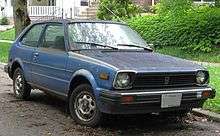Honda Civic (second generation)
| Honda Civic Second generation (SL/SS/SR/ST/VC/WD) | |
|---|---|
.jpg) | |
| Overview | |
| Manufacturer | Honda |
| Also called | Kaengsaeng Jaju II (North Korea) |
| Production | June 1979–September 1983 |
| Model years | 1980–1983 |
| Assembly |
Suzuka, Japan East London, South Africa Nelson, New Zealand (Honda New Zealand) Johor Bahru, Malaysia (OASB)[1] |
| Body and chassis | |
| Body style |
3/5-door hatchback 4-door sedan 5-door station wagon |
| Layout | FF layout |
| Related |
Triumph Acclaim Honda Ballade Honda Quint Honda Prelude |
| Powertrain | |
| Engine | |
| Transmission |
4/5-speed manual 3-speed Hondamatic automatic |
| Dimensions | |
| Wheelbase |
3-door:2,250 mm (89 in) 4/5-door:2,320 mm (91 in) |
| Length |
3-door :3,760 mm (148 in)- 3,870 mm (152 in) 4-door :4,090 mm (161 in) 5-door: 3,830 mm (151 in) |
| Width | 1,580 mm (62 in) |
| Height | 1,350 mm (53 in) |
| Curb weight |
3-door: 720 kg (1,587 lb)-780 kg (1,720 lb) 4-door:780 kg (1,720 lb)-835 kg (1,841 lb) 5-door:750 kg (1,653 lb)-780 kg (1,720 lb) |
| Chronology | |
| Predecessor | Honda Civic (first generation) |
| Successor | Honda Civic (third generation) |
The Honda Civic (second generation) debuted in June 1979 with a more angular shape, increased engine power, and larger dimensions in all models. The design was closer aligned to its larger sister, the Accord and the car was generally more comfortable and sophisticated than the first generation Honda Civic.[2]
Design
The wheelbase now measured 88.6 inches (2,250 mm) for the hatchback (the two-door "sedan" was dropped) and 91.3 inches (2,319 mm) for the wagon. The Civic engines came in cross flow and CVCC design depending on the market they were sold in; in North America the base 1335 cc ("1300") CVCC engine made 55 hp (41 kW), while the 1488 cc ("1500") CVCC engine produced 67 hp (50 kW). Three transmissions were offered: a four-speed manual (on base models), a five-speed manual and a three-speed automatic.[3]

_01.jpg)
In North America, the Civic 1300 and 1500 both came in base and DX versions. The latter featured a five-speed manual transmission, partial cloth seats, carpet, rear window defroster, intermittent wipers, and a cigarette lighter. The 1500 GL added radial tires, a rear window wiper/washer, tachometer, clock, and body side moldings. The Civic wagon came in a single version that was similar to the DX trim level.[3] The rather underpowered 1300 was not available in California and in some mountainous areas. While still a CVCC design, the stratified charge design was muted and emissions control was assisted by a small two-way catalyst.[4]
History
In September 1980 for model year 1981 a three-box four-door sedan debuted, as did a three-speed automatic transmission that replaced the aging two-speed unit fitted to the first generation Civic. The four-door was also marketed as the Honda Ballade in the Japanese domestic market.
A minor facelift arrived in late 1980. In early 1982 another facelift added larger plastic bumpers, a new grille and rectangular headlights.[5]
A somewhat larger Civic-based five-door hatchback arrived, called the Honda Quint in Japan. It was marketed at a Japanese dealership sales channel called Honda Verno along with the Honda Ballade, a high luxury model based on the Civic sedan. Also introduced was a new highly fuel efficient I4 model, the five-speed "FE" (Fuel Economy) which was rated at 41 mpg-US (5.7 L/100 km; 49 mpg-imp) in the city and 55 mpg-US (4.3 L/100 km; 66 mpg-imp) on the highway.[3] However, even the standard 1500-cc model achieves 34 mpg-US (6.9 L/100 km; 41 mpg-imp) city, and 47 mpg-US (5.0 L/100 km; 56 mpg-imp) highway when driven 55 mph (89 km/h), the maximum U.S. speed limit at the time (California mileage ratings).
The slogan for 1983 Civic was We Make It Simple. A sport-oriented Civic "S" was introduced in 1983 and was fitted with firmer suspension (with rear stabilizer bar) and 165/70R13 Michelin tires. A red accent encircled the S and set it apart from other Civics as well as a black grille and blackout paint around the window frames. This model was fitted with two different motors. In some markets it was fitted with the high performance 1335 cc EN4, which was of traditional cross-flow design, and was fitted with twin Keihin CV carburettors, and the same camshaft that was fitted to the earlier 1st generation GL models. The twin carburettors shared much in common with the legendary RS models of the mid-70s, using the same intake manifold, however Honda updated the configuration by fitting twin velocity stacks to help increase bottom-end and mid-range response. The Civic "S" was available in Red, and in Black. The Civic platform also spawned a new car, with an emphasis on performance, called the Honda Prelude.
.jpg)
A re-styled saloon version of this model was also sold, badged as the Ballade. This model was also made under licence by British Leyland, badged as the Triumph Acclaim, featuring new front and rear styling, as well as a revised interior.[3]
Notes
- ↑ EN1 = base model, EN4 = "S" model.
References
| Wikimedia Commons has media related to Honda Civic (1979). |
- ↑ Leeps (1989-06-04). "Rust Busters". New Straits Times / Google News Archive. Retrieved 2015-05-03.
- ↑ Hogg, Tony (ed.). "Honda Civic GL1500: Honda civilizes the Civic". Road & Track's Road Test Annual & Buyer's Guide 1981 (January–February 1981): 70.
- 1 2 3 4 "Generations". Edmunds. Retrieved 2006-11-05.
- ↑ Honda civilizes the Civic, pp. 71–72
- ↑ "Honda Civic (Mk2 Civic)". GoAuto. Retrieved 2015-09-03.